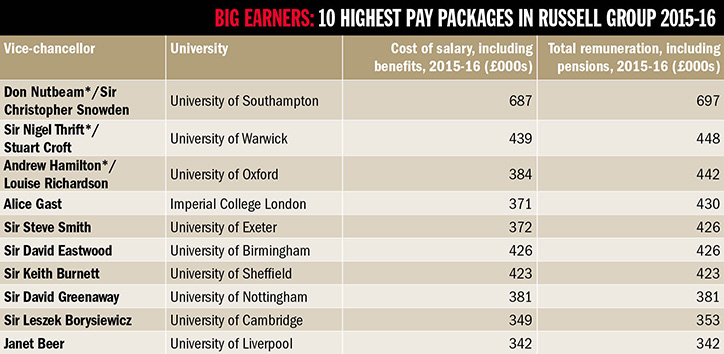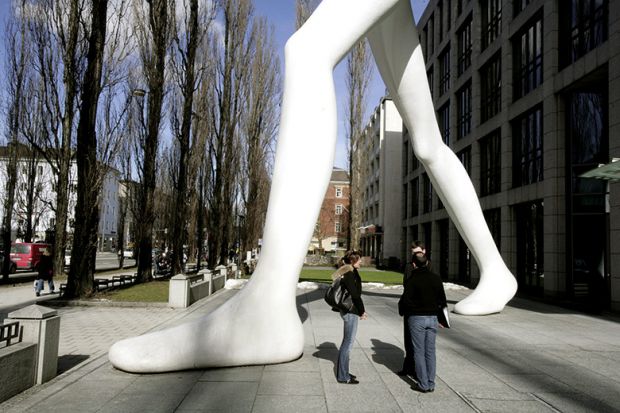The cost of paying the leaders of the UK’s top universities has soared yet again despite government warnings over rising executive pay, new figures show.
While rank-and-file academics received a 1 per cent pay rise in 2015-16, the average cost of paying the salary and benefits of a Russell Group vice-chancellor increased by 5.9 per cent to £342,200 in the same year – about £19,000 more than in 2014-15, according to a Times Higher Education analysis of 21 of the group’s 24 members.
Once pensions are included, the average cost of pay packages stood at £366,500 – 5.2 per cent higher than the average cost of the equivalent remuneration in 2014-15.
The news is likely to cause further dismay among university staff who staged a two-day walkout last May over this academic year’s 1.1 per cent pay offer. Staff also saw take-home pay fall last April as employee pension contributions increased, costing thousands of staff about £100 a month.
This year’s executive pay figures, released in newly published university accounts, also reveal how several Russell Group vice-chancellors received hefty bonuses, while one was given more than £250,000 on retiring a year earlier than planned.
According to the University of Southampton’s latest financial statements, Don Nutbeam, its former vice-chancellor, was paid £252,000 as “compensation for loss of office” in addition to a £43,000 “performance-related bonus” before stepping down at the end of September 2015, bringing his total remuneration for 2015-16 to £345,000.
With £352,000, including pensions contributions, paid to the new vice-chancellor Sir Christopher Snowden for the remaining 10 months of 2015-16, the cost of remuneration for Southampton’s head totalled £697,000 that year.
Gill Rider, the university’s chair of council, said that the opportunity to recruit Sir Christopher had arisen “more quickly than planned or anticipated” after Professor Nutbeam announced in July 2014 that he wished to retire at the end of his contract in September 2016 or before, if a suitable replacement was found.
“Professor Nutbeam was then able to leave and the university paid him until the end of his contract,” said Dr Rider, who added that the new vice-chancellor’s annual salary of £419,000 reflected the former Universities UK president’s “proven track record” and the “quality and high level of expertise which he brings to the university”.
However, such pay-offs and higher salaries should invite closer public scrutiny as government ministers warned about overly generous severance payments in the March 2016 letter on university grants, said Sally Hunt, general secretary of the University and College Union.
“It’s clear that the minister’s calls for self-restraint in vice-chancellor remuneration are falling on deaf ears and we need more transparency in how these bumper pay deals are agreed,” said Ms Hunt.
Professor Nutbeam’s final pay package, and transition arrangements at other universities, contributed heavily to rising leadership costs, our analysis shows. Once they are removed from calculations, Russell Group vice-chancellors’ average salaries rose by a more modest 3.7 per cent last year, or 3.3 per cent, if pensions are included.
A total of seven Russell Group universities paid their leaders more than £400,000 last year.

Considering the institutions with one leader in 2015-16, Alice Gast, president of Imperial College London, topped the UK pay league, with a total pay package of £430,000 once an £18,000 accommodation allowance and £59,000 in pension contributions are included.
Sir David Eastwood, vice-chancellor of the University of Birmingham, received a total package of £426,000 – £10,000 (2.4 per cent) more than in 2014-15 – while £426,000 was also awarded to Sir Steve Smith, vice-chancellor of the University of Exeter, whose total pay climbed by £26,000 (6.5 per cent) last year.
The University of Oxford paid a total of £442,000 to the two vice-chancellors it had in 2015-16, with Louise Richardson awarded £204,000 in salary and £35,000 in pension contributions for the first seven months of 2016.
Other high earners include Sir Keith Burnett, vice-chancellor of the University of Sheffield, whose £385,000 salary was enhanced last year by a bonus worth £33,296 – pushing his total pay to £422,706 in 2015-16, 9.7 per cent higher than in 2014-15.
Sir Keith’s remuneration reflected his role as the head of a “large and complex organisation with an annual turnover of about £600 million” and the “importance the university attaches to having a leader in higher education, who is highly respected within and beyond the sector, both in the UK and internationally”, said Tony Pedder, the university’s chair of council.
Wendy Piatt, director general of the Russell Group, pointed out that “many vice-chancellors have accepted only very modest increases”, but that pay levels were set by independent remuneration committees that included “expert representatives from outside the sector”.
“These experts understand the importance of attracting and retaining experienced individuals who can demonstrate the highest calibre of leadership and determine the appropriate level of award,” Dr Piatt said.
Despite the rising pay of UK vice-chancellors, average pay still lagged behind the amounts awarded to the leaders of elite universities in the US and Australia, analysis by THE shows.
According to data published by The Chronicle of Higher Education last month, in 2014-15 – the latest available figures – the average total compensation paid to an Ivy League president was $1,441,451 (or £923,753 when the conversion was made in 2014) – 7.2 per cent lower than the previous year.
Amy Gutmann, president of the University of Pennsylvania, was the Ivy League’s highest earner on $2,962,708 (£1,903,000 in 2014), with five leaders in the eight-strong group earning less than $1 million (£640,850 in 2014) in 2014-15.

In Australia’s Group of Eight university group, average salaries in 2015, not including pension contributions, stood at A$1,091,000 (£536,320 when the conversion was made in 2015), 4 per cent higher than in 2014, according to information collated by The Australian. Michael Spence, vice-chancellor of the University of Sydney, was the highest earner on A$1,385,000 (£680,846 in 2015), the paper reported.

POSTSCRIPT:
Print headline: Salary hikes for Russell Group v-cs beat staff pay rises again
Register to continue
Why register?
- Registration is free and only takes a moment
- Once registered, you can read 3 articles a month
- Sign up for our newsletter
Subscribe
Or subscribe for unlimited access to:
- Unlimited access to news, views, insights & reviews
- Digital editions
- Digital access to THE’s university and college rankings analysis
Already registered or a current subscriber?








